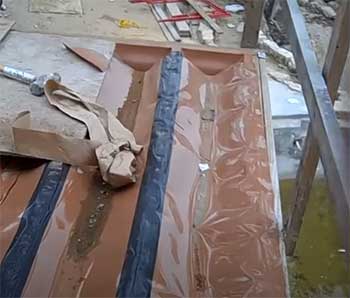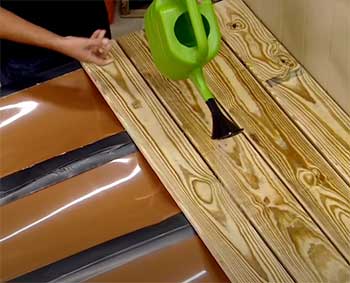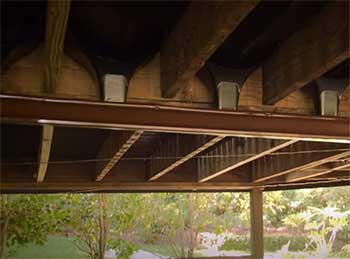The Trex RainEscape deck drainage system promises to be the solution to wet, slippery outdoor decking. By channeling water through a hidden under-deck system, Trex RainEscape is designed to keep your deck dry so you can enjoy it rain or shine.
But how well does it really work?

As a decking material, Trex composite deck boards have an excellent reputation.
Trex RainEscape aims to solve a common problem for any type of deck: inadequate drainage.
If puddles accumulate on your deck after it rains, you’ve got drainage issues.
Not only are puddles unsafe for walking, the standing water rots deck boards and corrodes the substructure.
While Trex RainEscape works adequately when first installed, many homeowners report problems over time. Issues range from clogged drains to leaks and severely flooded under-deck areas.
Before installing Trex RainEscape or any drainage system, it’s important to understand what can go wrong. We’ll look at the most common problems and their solutions. With proper maintenance and repair, you can still enjoy a dry deck using the Trex RainEscape system.
Common Issues With Trex RainEscape Deck Drainage
Trex RainEscape consists of a channel that runs between the joists with small openings that allow water to drain through. The channel empties into downspouts to direct water off the deck. Here are some of the most common problems that can develop:
- Clogged Water Channel
The plastic drainage channels easily fill with leaves, pine needles, sediment, and other debris. Homeowners report the need to frequently flush and unclog the channels, sometimes as often as monthly.
Even small accumulations of debris can block water flow into drain openings along the channel.
Prevention is key to avoiding clogged channels. Install gutter guard mesh or filters over all deck drain openings. This prevents debris from entering the channels.
Routinely sweep and vacuum around drain openings to remove accumulation before it can wash in. Annually flush channels thoroughly with a hose. For stuck debris, use a plastic pipe cleaner or unwind a metal clothes hanger to poke obstructions free.
Avoid allowing soil, mulch or plants from contacting the deck edge where drainage openings may become buried.
- Leaking Connections

The Trex RainEscape system uses special plastic fittings to join the channel pieces end-to-end and to connect downspouts.
Over time the vibration of walking on the deck can loosen these connections.
Gaps open allowing water to leak out underneath the deck instead of being channeled to the downspouts.
Inspect all Trex RainEscape connections at least annually for leakage. When installing, ensure connections are fully seated according to manufacturer instructions.
Apply silicone caulk around connections for an extra seal if needed. Tighten any loose fittings and replace damaged components. Check where downspouts connect to drain extensions and reattach as needed.
Extend downspouts further away from the structure if disconnections persist.
- Downspout Disconnections
It is common for downspouts to disconnect from drain line extensions that channel water away from the deck. The downspouts themselves also often work loose from their fittings on the outlet end of the drainage channels.
Vibration from traffic on the deck can cause downspouts to gradually work free. Impact from lawnmowers hitting extensions or wildlife nesting in drains can also cause dislodgement. Routinely check that all downspouts are securely attached at both ends.
Hand tighten any loose connections. Use additional straps or plastic ties to secure as needed. Extend downspout lines further away from the structure if disconnections persist.
- Under Deck Flooding
During periods of extremely heavy rainfall, the drainage system can become overwhelmed. Channels and downspouts cannot carry away the volume fast enough. Excess water then pools underneath the deck substructure leading to flooding.
If under deck flooding occurs, first check that all drainage components are clear of debris and functioning normally. For adequate drainage capacity, channels should slope 1/4 inch per foot minimum.
Add supplemental joists to increase slope in flatter sections. Improve perimeter drainage around the deck such as grading soil lower and adding French drains or dry creek beds. Discharge downspouts well away from the deck onto a sloped surface.
As a last resort, reduce flooding risk by decreasing the deck’s footprint or removing a portion of decking above.
- Improper Installation
Many drainage issues arise from improper installation of the Trex RainEscape system. Often the drainage slope is inadequate, preventing smooth water flow through the channels.
Low sections allow water to pool in the channels instead of draining freely to downspouts. The system can also settle out of position over time due to loose fasteners or foot traffic vibration.
To prevent installation problems, have a professional installer experienced with Trex RainEscape perform the work. Ensure channels slope 1/4 inch per foot minimum, adding supplemental joists as needed.
Follow all manufacturer specifications for correct channel spacing, fastening methods and connection fittings. Check for flat spots or settling after installation where water may pool. Make any needed adjustments during construction to ensure flawless drainage.
- Drain Openings Clog with Debris
Leaf litter, pine needles, and other debris collects over deck drain openings along the channel. Water can’t enter the drainage system and pools on the surface.
Routinely sweep and vacuum debris from the deck surface paying close attention to drain openings. Flush drain openings thoroughly with a hose.
- Standing Water Between Boards

Even when the drainage system works perfectly, water can still collect between deck boards after rain.
The flat surface of Trex and other composite boards allows water to puddle in the grooves.
Improve drainage between boards by sealing with a penetrating sealer annually.
This prevents water absorption and helps it shed immediately.
Routinely rinse the deck with a hose to clear standing water.
- Rotting Joists and Substructure
If water leaks through connections, accumulates from flooding, or seeps between boards it can lead to rotting framing. Wet wood attracts termites and compromises structural integrity.
Allow the substructure to dry fully after any water issues before making repairs. Replace any rotted wood. Treat wood with borate solution to deter future rotting. Improve drainage to prevent excess moisture.
- Rusting Fasteners
Metal screws, nails, and framing hardware will corrode faster in damp conditions underneath decks. This weakens the structure so boards become loose.
Use rust-resistant, stainless steel hardware for deck construction especially near water. Routinely inspect for corroding fasteners. Replace any compromised metal structural components.
- Mold and Mildew Growth
Standing water promotes mold growth on wood framing and the underside of decking. Mold creates unsightly stains and health hazards.
Improve drainage to eliminate standing water. Scrub away any mold growth promptly. Apply an antimicrobial solution after cleaning to inhibit further growth. Increase airflow underneath deck.
Trex RainEscape Drainage Options and Alternatives
If you are experiencing issues with your Trex RainEscape system, all is not lost. With some troubleshooting and maintenance it can be improved. But if problems persist, switching to an alternative drainage system may be your best option.
Here are some ways to enhance or replace Trex RainEscape:
- Install drainage mats underneath decking to channel water between boards. Mats have a dimpled surface that prevents puddling.
- Replace Trex RainEscape with another under deck drainage product like DrySnap that hangs below joists instead of between.
- Use rubber deck tiles elevated on pedestals over a gravel base. Water drains between the tiles.
- Slope the deck slightly for surface runoff and install drainage grates along the perimeter.
- Grade soil 6″-10″ below ledger board and install perimeter gravel trenches. Carry away water with French drains.
- Elevate deck framing on concrete piers or helical piles. Allow air circulation and water flow underneath.
Frequently Asked Questions (FAQ)
With proper installation and routine maintenance, Trex RainEscape should last as long as your deck itself, at least 15-25 years. Regular inspection and cleaning will maximize lifespan.
Other under deck drainage systems like DrySnap and Deckorators Vault work similarly to Trex RainEscape. Elevated deck tiles or free-standing decks improve airflow and drainage without an enclosed system.
The “best” system depends on your specific deck. But elevated decking with perimeter drainage and gravel trenches is most effective. Leaving the area under a deck open improves ventilation and prevents moisture issues.
Enclosed drainage systems like Trex RainEscape address symptoms but not the source of drainage issues. Preventing puddles on top is helpful but excess water will still collect underneath and promote rot. An open, elevated deck is lower maintenance.
Closing Remarks
While Trex RainEscape has its flaws, some drainage is better than allowing water to pool on your deck’s surface. With care taken during installation and routine maintenance afterward, the system can protect your deck for years to come.
Address any issues promptly before small problems lead to extensive repairs.
Improving drainage around the deck perimeter goes hand in hand with an under-deck system. For best results, elevate deck framing when possible to improve airflow. This prevents moisture from being trapped underneath a solid surface.
Combined with proper grading and landscaping, you can enjoy your deck rain or shine.
